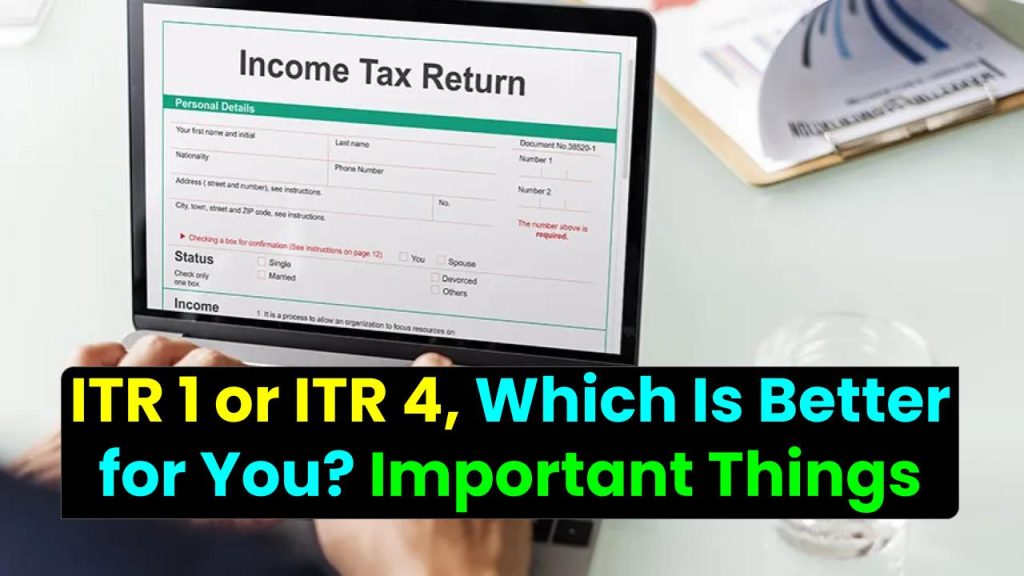
Filing your income tax return can be confusing, especially when you’re unsure whether to choose ITR-1 or ITR-4. These forms may seem similar, but they cater to very different types of taxpayers. Making the wrong choice can delay your refund or even lead to penalties.
In this article, we’ll walk you through everything you need to know about ITR-1 vs ITR-4, who should file which, and what you should always keep in mind before selecting the right form. Whether you’re a salaried employee or a small business owner using the presumptive taxation scheme, this guide will help you make the right choice.
ITR 1 or ITR 4, Which Is Better for You?
| Topic | Details |
|---|---|
| ITR-1 Eligibility | For salaried individuals earning up to ₹50 lakh with income from salary, one house property, and other sources (excluding lottery/gambling). |
| ITR-4 Eligibility | For residents earning up to ₹50 lakh from business or profession under presumptive taxation (Sections 44AD, 44ADA, 44AE). |
| Who Should Not File ITR-1 or ITR-4 | Those with foreign assets, capital gains, multiple house properties, or directorship in a company. |
| Deadline to File ITR | 31st July 2025 for AY 2025-26 (unless extended by CBDT). |
| Penalty for Late Filing | ₹1,000 to ₹5,000 depending on income slab. |
| Best For | ITR-1: Salaried employeesITR-4: Freelancers, professionals, small businesses using presumptive taxation |
Deciding between ITR-1 and ITR-4 doesn’t have to be complicated. The key is to understand your income sources. If you’re a salaried person with no business income, ITR-1 is your go-to form. If you’re a freelancer, professional, or small business owner using presumptive taxation, then ITR-4 is your best bet.
What Is ITR-1 (Sahaj)?
ITR-1, also known as Sahaj, is meant for individuals with simple income structures. You can file ITR-1 if:
- You are a resident individual
- Your total income is up to ₹50 lakh
- Your sources of income include:
- Salary or pension
- Income from one house property
- Other sources (like savings account interest, FD interest)
- Agricultural income up to ₹5,000
Example:
If you are a salaried IT employee earning ₹12 lakh a year, with a home loan and some bank interest income, ITR-1 is ideal for you.
see also: You Can Add 4 Nominees in Your Nominees Account at the Same Time
Who Cannot File ITR-1?
You cannot use ITR-1 if you:
- Have foreign assets or foreign income
- Are a director in a company
- Have capital gains
- Own more than one house property
- Earn agricultural income over ₹5,000
- Invested in unlisted equity shares
- Are a non-resident or RNOR (Resident but Not Ordinarily Resident)
What Is ITR-4 (Sugam)?
ITR-4, also called Sugam, is designed for taxpayers who have opted for the presumptive taxation scheme under:
- Section 44AD (Small businesses)
- Section 44ADA (Professionals like doctors, lawyers, architects)
- Section 44AE (Transporters owning up to 10 vehicles)
You can file ITR-4 if:
- You’re an individual, HUF, or a firm (not LLP)
- You’re a resident and your total income is up to ₹50 lakh
- You earn from:
- Business/profession under presumptive scheme
- Salary/pension
- One house property
- Other sources (excluding lottery, gambling)
Example:
A freelance graphic designer earning ₹30 lakh annually and choosing presumptive taxation can use ITR-4.
Who Cannot File ITR-4?
Avoid ITR-4 if:
- You have foreign income or assets
- You’re a director in a company
- Your income includes capital gains
- You own more than one house property
- You hold unlisted equity shares
- You’re a non-resident or RNOR
- You want to claim actual expenses rather than presumptive income
ITR 1 or ITR 4: Detailed Comparison
| Feature | ITR-1 | ITR-4 |
|---|---|---|
| Total Income Limit | Up to ₹50 lakh | Up to ₹50 lakh |
| Type of Income | Salary, one house, other sources | Presumptive income (business/profession), plus salary/house/other |
| Business Income Allowed? | No | Yes (under presumptive scheme) |
| Foreign Income/Assets | Not allowed | Not allowed |
| Multiple House Properties | No | No |
| Capital Gains | Not allowed | Not allowed |
| Applicable To | Individuals only | Individuals, HUFs, firms (except LLPs) |
When to Choose ITR-4 Over ITR-1
Use ITR-4 if you:
- Run a small business or profession (doctor, consultant, shop owner, etc.)
- Want to opt for presumptive taxation (declare fixed percentage of income)
- Don’t want the hassle of maintaining books of accounts
- Have total income under ₹50 lakh
Use ITR-1 if you:
- Earn a fixed salary
- Have no business/professional income
- Only earn from one house property and interest
How to File ITR 1 or ITR 4 Online – Step-by-Step Guide
- Visit the official portal
- Log in using your PAN and password
- Select “e-File > Income Tax Return”
- Choose:
- Assessment Year: 2025-26
- Mode: Online
- ITR Form: ITR-1 or ITR-4 (whichever is applicable)
- Fill in:
- Personal details
- Income details (salary, business income, etc.)
- Deductions (80C, 80D, etc.)
- Preview and validate the form
- Submit and e-verify via Aadhaar OTP or Netbanking
Tip: Use Form 16 (for salaried) or maintain invoices (for professionals) to cross-check income.
Common Mistakes to Avoid
- Choosing the wrong ITR form
- Skipping verification after submission
- Not reporting all income (e.g., interest from FDs)
- Missing the deadline (31 July)
- Ignoring advance tax (if applicable)
Filing with the wrong ITR may lead to a defective return under Section 139(9).
see also: Post Office’s Popular Scheme: You Will Get a Return of ₹1,71,276 in Just 5 Years
ITR 1 or ITR 4 FAQs
1. Can I switch from ITR-4 to ITR-1 next year?
Yes, if your income structure changes (e.g., you stop freelancing), you can shift to ITR-1 next year.
2. Do salaried individuals need to file ITR-4?
Only if they have additional presumptive business income. Otherwise, ITR-1 is sufficient.
3. What if I make a mistake while choosing the form?
You may receive a notice under Section 139(9). You’ll need to revise the return using the correct ITR.
4. Can NRIs file ITR 1 or ITR 4?
No. Only residents can use these forms.
5. Is presumptive taxation beneficial?
Yes, if you want to avoid bookkeeping and declare income at a standard rate. But you can’t claim actual expenses.











